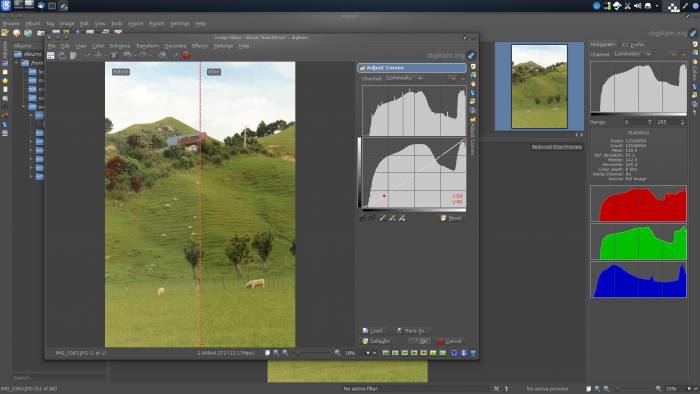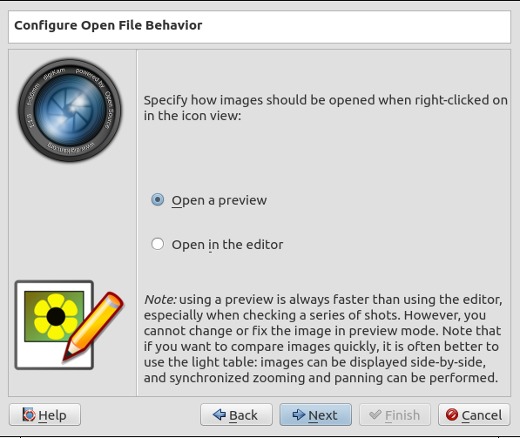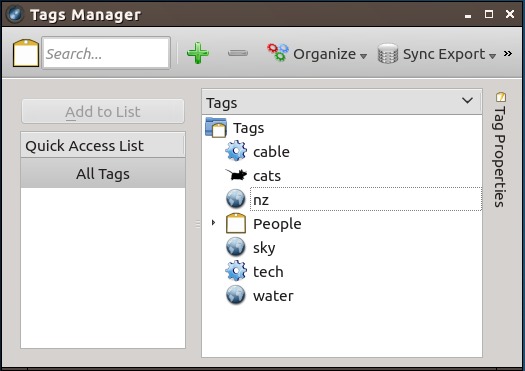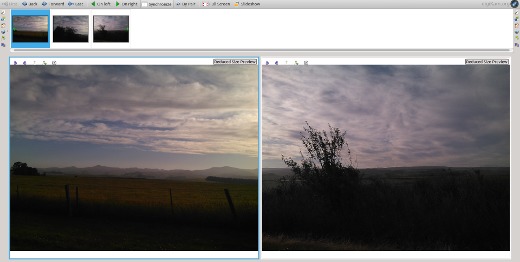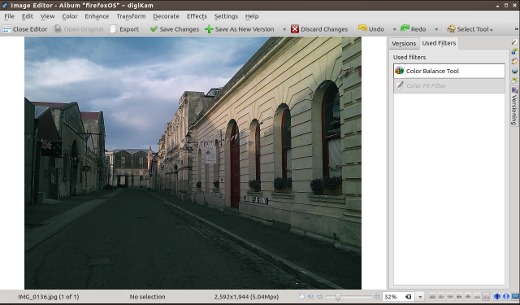Digikam
Strengths [Weaknesses]
Photo Management
Digital photography has left most people with thousands of photos that they never look at because they cannot begin to organise them all. Digikam is a powerful and flexible organisational environment with the ability to proof and process the best of your shots.
Configurable
The KDE family is know for configurability, and Digikam is no exception. They're your photographs, so you deal with them anyway you want; Digikam will help, but never get in your way.
Weaknesses [Strengths]
Complex
This is an application filled with features and configuration options, so it takes time to learn it entirely, and then more time to decide which features you want to use and which ones you want to ignore.
Linear Editing
Compared to Darktable, which configures non-linear filters through which you may view and export those images, Digikam modifies the pixels of the image and applies filters linearly (although it manages versions quite well and does not overwrite your photo unless you force it).
Not a Compositor
Digikam is not GIMP. It promotes a different workflow and does not have the extensive compositing features that GIMP has.
Digikam is a capable digital darkroom application as well as to photo managers. It has a rich plugin structure which enables the addition of even more features as the need arises (such as quick uploaders to popular online photo shares, new filters, and so on). Even if a graphic artist or photographer is happy using GIMP, Digikam is a useful tool for its photo management features and darkroom effects.
While GIMP concentrates on enabling an artist to open an image for re-touching, compositing, and general manipulation, Digikam is first a photo management and proofing tool. It has fine-grain settings tuned to let you see your work in a variety of ways. whether you prefer to see them as life events, photo sessions, collections, or just as files and directories. It features a “light table” so that you can compare different takes of the same shot, and once you choose the best of multiple images, it has a built in image editor with image versioning.
Digikam's image editor features the basics, such as colour correction and exposure adjustment, but it also has effects and plugins. image correction and even has a robust set of plugins and filters, including facial recognition, uploaders for over a dozen popular image sharing websites, importers, exporters, film emulation for popular manufacturers and stocks, paint effects, text rendering, panorama combining, and much much more.
Install
Digikam is installable from http://slackbuilds.org. The features that you want in Digikam governs the dependencies required to build it. This can become complex, especially if you are attempting to install very new versions of Digikam on older editions of Slackware. Unless there's some exciting new feature that's only available in the latest version of Digikam, it's usually easiest to take the most recently approved version that http://slackbuilds.org has on offer. Digikam is mostly in the enviable position of being basically stable, with new releases being primarily minor fixes and upgrades.
First Launch
Upon first launch, there's a brief setup wizard to step through. Some choices affect performance and file size, so read the screen carefully to decide what you really want, but all of the decisions can be changed later, so accepting the defaults is safe if you're not sure.
The initial launch will be slower than usual, since Digikam must analyse the photographs in your collection and record information about each one. Depending on how many photos you have and how large they are, you might want to let it run over night.
Interface
The layout of Digikam is fairly intuitive, especially if you're a regular KDE (the default desktop of Slackware) user. The basics are pretty simple: on the left are panels that control how you view photos, in the middle are the photos themselves, and on the left are effects and filters.
The initial default view is a file system view, starting from whatever directory you defined as your image folder during setup. Digikam refers to whatever directories it finds within your image directory as an Album, and it parses each image file, along with its native metadata plus metadata Digikam allows you to add, into a thumbnail view.
When you select a directory (an “album”), the photos within are displayed as an array in the right panel. There are plenty of other ways to view your photos, though, and they're all accessible as vertical tabs (a time-honoured tradition of the KDE interface) along the left edge of the main window. In addition to the Album view, there are:
Tags to filter the photos in your collection by arbitrary metadata
tags. There probably won't be tags at first (unless you've created or imported some), but you can create tags in the Tag Manager interface and assign them to pictures. Clicking on any tag (or control-clicking on several tags) in the Tag panel filters the thumbnail view to show photos with that tag assigned.
Labels to filter your photos according to how many stars you've
assigned to a photograph. There are other forms of labels, such as colour labels and flags, all user-assignable from the thumbnail view.
Dates, Timeline, and Map views let you see photos by relevant
data contained in the photo's EXIF information.
People to scan your photo collection for faces. Digikam recognises faces as faces, and can even take guesses as to their identities (an “experimental” feature). Scanning your entire collection from the very start can take a while, but once the initial scan is done, Digikam only scans photos upon import, so be patient on the first use and you won't even notice it happening from then on.
There are more filtration options, including fuzzy searches to find images similar to one another, a sketch search to try to match a photo with a rough drawing of what you're looking for, and more.
Thumbnail View
The thumbnail view is the central panel of Digikam, but its right-click menu provides a host of important features, like switching to fullscreen mode, assigning tags, and assigning labels. It also performs file management functions and provides access to Digikam's digital darkroom interface.
Aside from organising your photos, the first thing you're likely to do once you have imported an SD card full of pictures is to figure out which of the group are the really good ones, and especially choose between several very similar shots of the same subject. The method Digikam provides for this is its light table view: a separate window that helps you focus on just two or three photographs at a larger size than a little thumbnail.
To add a photo to your light table, either right-click on it and select Add to Light Table or select a photo and press Ctrl-L. Since it's often used for comparing photos, you can add several photos to the light table at once; to add more photos, either right-click and select Add to Light Table again or press Ctrl-Shift-L.
The light table interface also has facial recognition overrides. If you've got a photo that Digikam hasn't identified faces in, or has mis-identified faces, then load it into the light table and right-click on the image. Select Add a Face Tag for the face tag editor. Draw a box around the face that you want to identify, and type the person's name into the text field.
The thumbnail view also can help manage your photos. Right-clicking enables common file management tasks, like renaming photos, adding a photo to a specific album, or moving irreparable ones to the trash, and so on.
To see information about a photo, use the vertical tabs on the right edge of the Digikam window. These show metadata, colour data, versioning data, and more.
Also from the thumbnail view, you can edit photos using Digikam's robust effect plugins.
Editing and Effects
Digikam has an inbuilt editor for most common photo effects and touch-ups. To get there, select a photo and click the Image Editor button along the top toolbar. This opens a new window for dedicated editing.
The image editor interface has two entry points for nearly every function: you can select effects from the window menu or from the Select Tool button in the top toolbar.
All the usual effects are present; colour balance, saturation, levels, red-eye removal, and so on. Special effects are included too; textures, oil paint filters, borders, film grains, film emulation (profiled by popular film stocks), and much much more. It's safe to try them all, because none of them alter your original photo until you save the changes.
Filters and effects can be un-done, too, from the Edit menu, but only in the order they were applied. The filters are linear (unlike in Darktable, where filters are truly filters that can be slotted in at different points in the filter stack), so if you apply a Colour Balance filter and then a Vivid effect, if you undo the Colour Balance then you also implicitly undo the Vivid effect that followed it.
To see the effects applied to a photograph, click the Versioning tab along the right side of the Image Editor window and select the Used Filters tab.
When you're finished, save your changes directly to your original photo, or save the changes as a new version. If you save a photo as a new version, then you'll see your new version in your thumbnail view, but you'll always have the option to view previous versions.
Exporting
Getting images out of Digikam, strictly speaking, is automatic, because photos are never “in” Digikam. Digikam reads images straight from your file system, so to get an image from Digikam, all you have to do is look in the place you last left it. It'll still be there.
In fact, not just the photo will be there; saved versions of the photo will also be there, named as you'd expect (the first new version of IMG0033.jpg becomes IMG0033.v1.jpg, and so on).
Digikam does have some convenient export options, though, depending on how you installed it (certain export options require additional libraries that you may or may not ever need). Export targets include Piwigo, email, Flickr, Google Photos, Google Drive, Facebook, Debian Screenshots, MediaWiki, SmugMug, raw HTML, any remote computer you have an account on, and, believe it or not, many many more.
Documentation
Digikam is an easy but powerful photo management and re-touching application. It's got lots of great features, and this article has only touched on the basics. An ebook with Digikam “recipes” is available from one of the developers: http://scribblesandsnaps.com/2015/05/11/buy-digikam-recipes-get-practical-exiftool, with proceeds benefitting further Digikam development.
